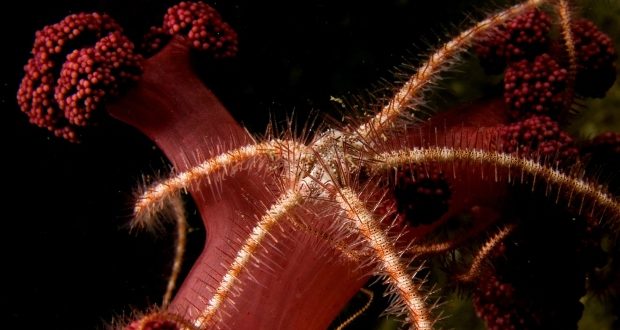Cold and entirely without light, the deepest regions of the ocean were long believed to be barren and uninhabitable. In the body of scientific knowledge, discovery of life within the deep blue planet is relatively young. Although it covers 66 per cent of the global seafloor area, the deep ocean has remained a ‘black box’ in terms of global patterns of biodiversity — until now.
In an effort to better understand the kind of life found at these depths, an international team of scientists, including two Dal scientists, has mapped and predicted seafloor biodiversity for the first time. Their findings were published in Nature on Wednesday.
“I’m sure that I’m not alone in thinking that the deep sea is a fascinating environment, and utterly unique,” says Derek Tittensor, a co-author of the study and adjunct professor in the Department of Biology. “It’s cold, lightless and under extremely high pressure — yet there’s a magnificent and beautiful diversity of life there.”
The study used records from many of the world’s museums and existing scientific literature to map the location of different species of brittle stars. These spindly-legged relatives of starfish are a dominant part of seafloor life. Their presence at all depths makes brittle stars an ideal species group to reveal changing patterns of diversity with depth. The researchers found that deep-sea brittle stars show patterns of diversity that are unlike anywhere else on Earth.
Surprising discoveries
The highest biodiversity, globally speaking, is found in the tropical regions of the planet — both on land and in shallow depths of the ocean.
“As you move deeper [in the ocean], everything changes,” says Boris Worm, a Biology professor and co-author of the study. “We’ve found a new mechanism by which diversity is generated.”
In the surface depths of the ocean, sunlight is the prime form of energy driving evolution to develop rich biodiversity, and it’s more consistently found at high intensity in the tropics. But in the deep ocean, life and diversity must rely on a different kind of fuel. One of the paper’s key findings demonstrates that higher amounts of biodiversity in the deep ocean are actually found at the planet’s higher latitudes near continents, starkly contrasting the relationship between geography and biodiversity that biologists have been familiar with for decades.
Dr. Worm explains the break in pattern can be attributed to the large-scale algal blooms that occur off the coasts in tandem with seasons experienced at higher latitudes. A buildup of nutrients in the winter and increased sunlight in the spring causes the rapid growth of plankton at the surface. As the bloom grows and drifts, clumps of plankton start to sink down to the ocean floor. Coined “marine snow,” these sinking particles fuel — through chemical energy rather than solar — biodiversity in the deep.
International collaboration for conservation
Museum Victoria and University of Melbourne PhD candidate Skipton Woolley led the study. Drawn to Dalhousie for its long-standing expertise in marine biodiversity research, Woolley worked on campus for several months to collaborate with Dr. Worm and Dr. Tittensor. The team’s research is an important first step for conservation efforts in the deep ocean. Slow to grow and recover, the sea floor faces increasing threats from mineral exploration, deep sea fishing trawlers and climate change.
“With the mining of minerals on the seafloor slowly becoming a reality, it’s vital that we understand the conservation needs of animals that live at these great depths,” says Woolley.
“There’s a lot of discussion at the United Nations on biodiversity on the High Seas — the Areas Beyond National Jurisdiction,” adds Dr. Tittensor, who’s also senior marine biologist at the United Nations Environment Programme World Conservation Monitoring Centre. “This is the type of work that will feed into these discussions.”
The team hopes that as data from around the world is collected, global maps of seafloor diversity will continue to become more detailed and cover a wider range of marine life, increasing knowledge about the distribution of marine biodiversity.
Agencies/Canadajournal/Press Releases

 Canada Journal – News of the World Articles and videos to bring you the biggest Canadian news stories from across the country every day
Canada Journal – News of the World Articles and videos to bring you the biggest Canadian news stories from across the country every day

